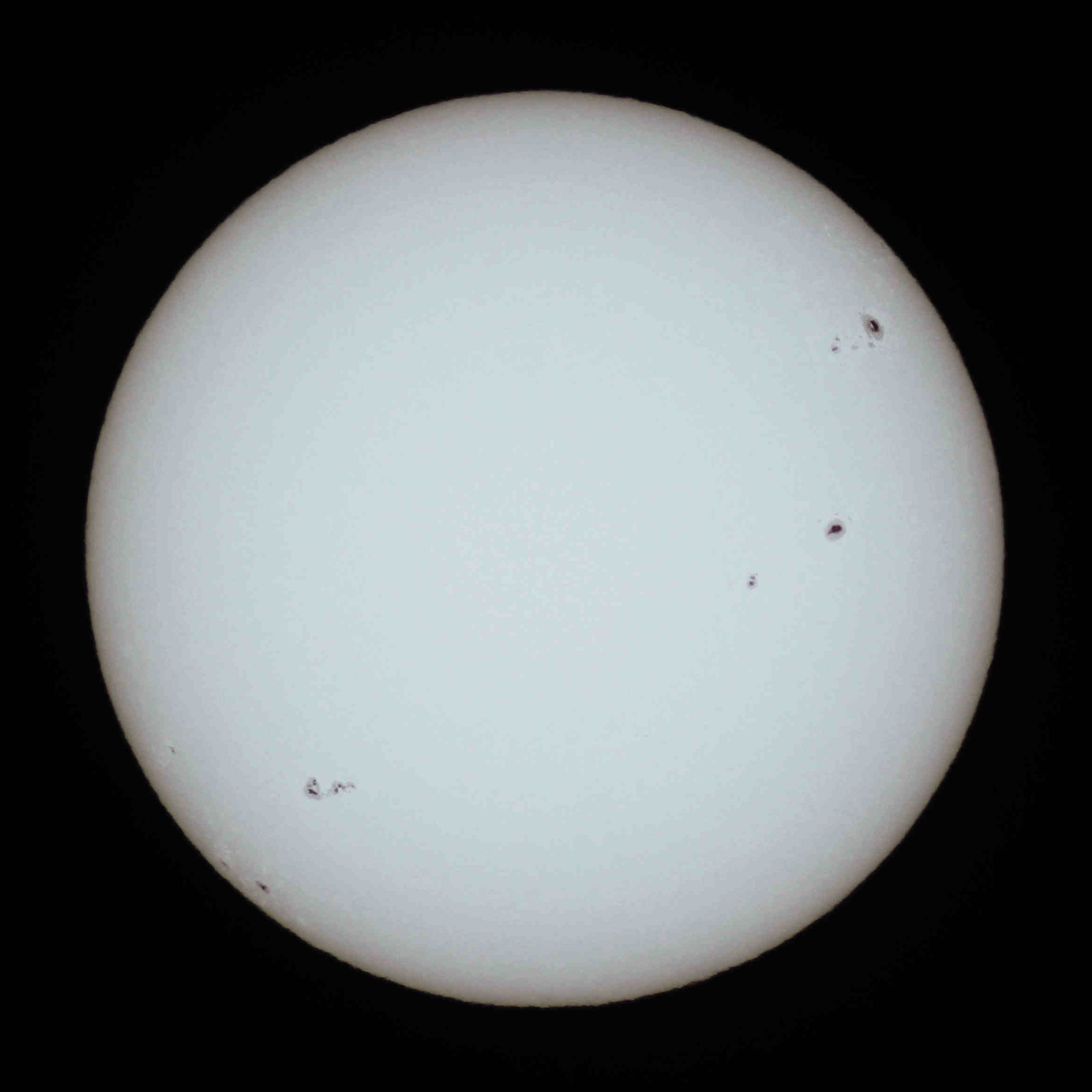|
WASP-34
WASP-34, also named Amansinaya, is a sunlike star of spectral type G5V that has 1.01 ± 0.07 times the mass and 0.93 ± 0.12 times the diameter of the Sun. It rotates on its axis every 34 ± 15 days, indicating it is around 6.7 billion years old. Planetary system It has a planet 0.59 ± 0.01 times as massive as Jupiter that takes 4.317 days to complete an orbit. Planetary color was found to be redder than usual, hinting on peculiar chemistry. The planet has a large measured temperature difference between dayside (1185 K) and nightside (726 K). There is increasing evidence that there is a massive object orbiting the system further out. Naming In 2019 the IAU announced as part of NameExoWorlds that WASP-34 and its planet WASP-34b would be given official names chosen by school children from The Philippines. The star is named Amansinaya, after Aman Sinaya, which is one of the two trinity deities of the Philippine's Tagalog mythology, and is the primordial deity of the ... [...More Info...] [...Related Items...] OR: [Wikipedia] [Google] [Baidu] |
Wide Angle Search For Planets
WASP or Wide Angle Search for Planets is an international consortium of several academic organisations performing an ultra-wide angle search for exoplanets using transit photometry. The array of robotic telescopes aims to survey the entire sky, simultaneously monitoring many thousands of stars at an apparent visual magnitude from about 7 to 13. WASP is the detection program composed of the Isaac Newton Group, IAC and six universities from the United Kingdom. The two continuously operating, robotic observatories cover the Northern and Southern Hemisphere, respectively. SuperWASP-North is at Roque de los Muchachos Observatory on the mountain of that name which dominates La Palma in the Canary Islands. WASP-South is at the South African Astronomical Observatory, Sutherland in the arid Roggeveld Mountains of South Africa. These use eight wide-angle cameras that simultaneously monitor the sky for planetary transit events and allow the monitoring of millions of stars simultaneousl ... [...More Info...] [...Related Items...] OR: [Wikipedia] [Google] [Baidu] |
Crater (constellation)
Crater is a small constellation in the southern celestial hemisphere. Its name is the latinization of the Greek ''krater'', a type of cup used to water down wine. One of the 48 constellations listed by the second-century astronomer Ptolemy, it depicts a cup that has been associated with the god Apollo and is perched on the back of Hydra the water snake. There is no star brighter than third magnitude in the constellation. Its two brightest stars, Delta Crateris of magnitude 3.56 and Alpha Crateris of magnitude 4.07, are ageing orange giant stars that are cooler and larger than the Sun. Beta Crateris is a binary star system composed of a white giant star and a white dwarf. Seven star systems have been found to host planets. A few notable galaxies, including Crater 2 and NGC 3981, and a famous quasar lie within the borders of the constellation. Mythology In the Babylonian star catalogues dating from at least 1100 BC, the stars of Crater were possibly incorporated with those ... [...More Info...] [...Related Items...] OR: [Wikipedia] [Google] [Baidu] |
2MASS Objects
Mass is an intrinsic property of a body. It was traditionally believed to be related to the quantity of matter in a physical body, until the discovery of the atom and particle physics. It was found that different atoms and different elementary particles, theoretically with the same amount of matter, have nonetheless different masses. Mass in modern physics has multiple definitions which are conceptually distinct, but physically equivalent. Mass can be experimentally defined as a measure of the body's inertia, meaning the resistance to acceleration (change of velocity) when a net force is applied. The object's mass also determines the strength of its gravitational attraction to other bodies. The SI base unit of mass is the kilogram (kg). In physics, mass is not the same as weight, even though mass is often determined by measuring the object's weight using a spring scale, rather than balance scale comparing it directly with known masses. An object on the Moon would weigh ... [...More Info...] [...Related Items...] OR: [Wikipedia] [Google] [Baidu] |
Stars With Proper Names
A star is an astronomical object comprising a luminous spheroid of plasma held together by its gravity. The nearest star to Earth is the Sun. Many other stars are visible to the naked eye at night, but their immense distances from Earth make them appear as fixed points of light. The most prominent stars have been categorised into constellations and asterisms, and many of the brightest stars have proper names. Astronomers have assembled star catalogues that identify the known stars and provide standardized stellar designations. The observable universe contains an estimated to stars. Only about 4,000 of these stars are visible to the naked eye, all within the Milky Way galaxy. A star's life begins with the gravitational collapse of a gaseous nebula of material composed primarily of hydrogen, along with helium and trace amounts of heavier elements. Its total mass is the main factor determining its evolution and eventual fate. A star shines for most of its active life d ... [...More Info...] [...Related Items...] OR: [Wikipedia] [Google] [Baidu] |
G-type Main-sequence Stars
A G-type main-sequence star (Spectral type: G-V), also often, and imprecisely called a yellow dwarf, or G star, is a main-sequence star (luminosity class V) of spectral type G. Such a star has about 0.9 to 1.1 solar masses and an effective temperature between about 5,300 and 6,000 K. Like other main-sequence stars, a G-type main-sequence star is converting the element hydrogen to helium in its core by means of nuclear fusion, but can also fuse helium when hydrogen runs out. The Sun, the star in the center of the Solar System to which the Earth is gravitationally bound, is an example of a G-type main-sequence star (G2V type). Each second, the Sun fuses approximately 600 million tons of hydrogen into helium in a process known as the proton–proton chain (4 hydrogens form 1 helium), converting about 4 million tons of matter to energy. Besides the Sun, other well-known examples of G-type main-sequence stars include Alpha Centauri, Tau Ceti, Capella and 51 Pegasi. The term ... [...More Info...] [...Related Items...] OR: [Wikipedia] [Google] [Baidu] |
Planetary Systems With One Confirmed Planet
Planetary means relating to a planet A planet is a large, rounded astronomical body that is neither a star nor its remnant. The best available theory of planet formation is the nebular hypothesis, which posits that an interstellar cloud collapses out of a nebula to create a ... or planets. It can also refer to: ;Science * Planetary habitability, the measure of an astronomical body's potential to develop and sustain life * Planetary nebula, an astronomical object ;People * Planetary (rapper), one half of east coast rap group OuterSpace ;Arts, entertainment, and media * ''Planetary'' (comics), a comic book series by Warren Ellis and John Cassaday * " Planetary (Go!)", a 2011 song by rock band My Chemical Romance * '' Planetary Radio'', a public radio show about space exploration, produced by The Planetary Society ;Organizations * The Planetary Society, the Earth's largest space interest group ;Technology * Epicyclic gearing (planetary gearing), an automotive tra ... [...More Info...] [...Related Items...] OR: [Wikipedia] [Google] [Baidu] |
Fisherman
A fisher or fisherman is someone who captures fish and other animals from a body of water, or gathers shellfish. Worldwide, there are about 38 million commercial and subsistence fishers and fish farmers. Fishers may be professional or recreational. Fishing has existed as a means of obtaining food since the Mesolithic period.Profile for the USA * inadequate preparation for emergencies * poor vessel maintenance and inadequate safety equipment * lack of awareness of or ignoring stability issues. Many fishers, while accepting that fishing is dangerous, staunchly defend their independence. Many proposed laws and additional regulation to increase safety have been defeated because fishers oppose them. Alaska's commercial fishers work in one of the world's harshest environments. Many of the hardships they endure include isolated fishing grounds, high winds, seasonal darkness, very cold water, icing, and short fishing seasons, where very long work days are the norm. Fatigue, physical ... [...More Info...] [...Related Items...] OR: [Wikipedia] [Google] [Baidu] |
Ocean
The ocean (also the sea or the world ocean) is the body of salt water that covers approximately 70.8% of the surface of Earth and contains 97% of Earth's water. An ocean can also refer to any of the large bodies of water into which the world ocean is conventionally divided."Ocean." ''Merriam-Webster.com Dictionary'', Merriam-Webster, [...More Info...] [...Related Items...] OR: [Wikipedia] [Google] [Baidu] |
Tagalog People
The Tagalog people ( tl, Mga Tagalog; Baybayin: ᜋᜅ ᜆᜄᜎᜓᜄ᜔) are the largest ethnolinguistic group in the Philippines, numbering at around 30 million. An Austronesian people, the Tagalog have a well developed society due to their cultural heartland, Manila, being the capital city of the Philippines. They are native to the Metro Manila and Calabarzon regions of southern Luzon, and comprise the majority in the provinces of Bulacan, Bataan, Nueva Ecija and Aurora in Central Luzon and in the islands of Marinduque and Mindoro in Mimaropa. Etymology The commonly perpetuated origin for the endonym "Tagalog" is the term ''tagá-ilog'', which means "people from longthe river" (the prefix ''tagá-'' meaning "coming from" or "native of"). However, this explanation is a mistranslation of the correct term ''tagá-álog'', which means "people from the ford". Historical usage Before the colonial period, the term "Tagalog" was originally used to differentiate rive ... [...More Info...] [...Related Items...] OR: [Wikipedia] [Google] [Baidu] |
Aman Sinaya
Aman may refer to:Poli People First names * Aman Hambleton (born 1992), Canadian chess grandmaster * Aman Hayer (born 1979), Bhangra musician * Aman Verma (actor) (born 1971), Indian actor Surnames * Mohammed Aman (born 1994), Ethiopian middle-distance runner * Rami Aman, Palestinian journalist and peace activist in the Gaza Strip * Theodor Aman (1831–1891), Romanian painter Nicknames * Cao Cao (155–220), Chinese warlord of the Three Kingdoms nicknamed "Aman" Entertainment * ''Aman'' (film), 1967 Bollywood film, by Mohan Kumar, starring Rajendra Kumar and Saira Banu * ''A.M.A.N.'' (TV series), a Greek television comedy series aired by ANT1 * Aman (Tolkien), a fictitious location in J. R. R. Tolkien's legendarium, also known as the Undying Lands * ''Aman'' (album), a 2015 album by Myriam Fares * "Aman" (song), a 2020 single by Albanian singer Dafina Zeqiri featuring Albanian rappers Ledri Vula and Lumi B Other * Aman (Islam) or ''amān'', assurance of securit ... [...More Info...] [...Related Items...] OR: [Wikipedia] [Google] [Baidu] |
Philippines
The Philippines (; fil, Pilipinas, links=no), officially the Republic of the Philippines ( fil, Republika ng Pilipinas, links=no), * bik, Republika kan Filipinas * ceb, Republika sa Pilipinas * cbk, República de Filipinas * hil, Republika sang Filipinas * ibg, Republika nat Filipinas * ilo, Republika ti Filipinas * ivv, Republika nu Filipinas * pam, Republika ning Filipinas * krj, Republika kang Pilipinas * mdh, Republika nu Pilipinas * mrw, Republika a Pilipinas * pag, Republika na Filipinas * xsb, Republika nin Pilipinas * sgd, Republika nan Pilipinas * tgl, Republika ng Pilipinas * tsg, Republika sin Pilipinas * war, Republika han Pilipinas * yka, Republika si Pilipinas In the recognized optional languages of the Philippines: * es, República de las Filipinas * ar, جمهورية الفلبين, Jumhūriyyat al-Filibbīn is an archipelagic state, archipelagic country in Southeast Asia. It is situated in the western Pacific Ocean and consists of aro ... [...More Info...] [...Related Items...] OR: [Wikipedia] [Google] [Baidu] |
.jpg)


